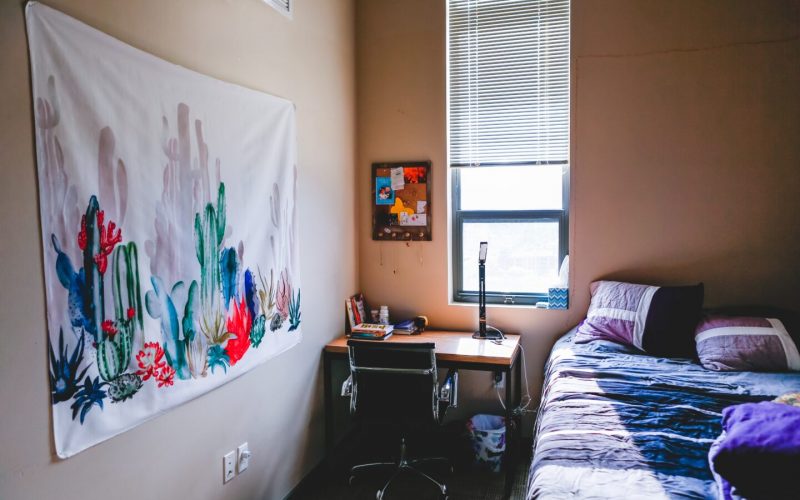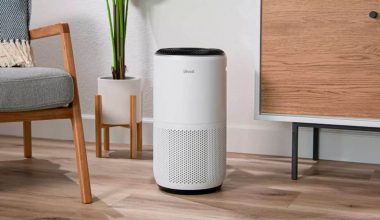During your college years, your dorm room will serve as your home away from home. It will become a space where you study, relax, and catch up on much-needed sleep. But when the scorching summer heat hits, this cozy haven can quickly turn into a stuffy and uncomfortable sauna, leaving you to find how to cool down your dorm room and reclaim your oasis of comfort.
Did you know you don’t have to melt away just because your dorm doesn’t have fancy air conditioning? That’s where this piece on how to cool down a dorm room comes in. There are numerous ways to keep your space cool and comfortable. From maximizing airflow with fans and creating DIY air coolers to optimizing natural ventilation and controlling heat sources.
In this guide, we’ll explore a variety of practical and creative strategies to beat the heat and transform your dorm room into a refreshing sanctuary. We’ll also look into the importance of bedding choices, dehumidifiers, and cooling techniques that can help you lower your body temperature and sleep more soundly during those hot summer nights.
So, read through!
Table of contents
Do Dorms Get Hot?
Yes, dorms can indeed get hot, especially during the sweltering summer months, and here are some reasons:
- Dorm Design and Ventilation: Dormitories are often designed with efficiency and cost-effectiveness in mind. As a result, they may not have the best insulation or ventilation systems compared to other buildings. Inadequate insulation can allow heat to seep into the rooms, while poor ventilation restricts the airflow necessary for cooling. Combined, these factors can create a hot and stuffy environment inside dorm rooms.
- High Occupancy: Dorms are typically filled with students, and the concentrated population can contribute to increased heat levels. The body heat generated by numerous individuals, coupled with the use of electronic devices, can cause the temperature to rise. When many students are using fans or even small appliances like mini-fridges, it adds to the overall heat load in the dorm.
- Limited Control over Temperature: In some dormitories, students may have limited control over the temperature in their rooms. Centralized heating and cooling systems may be regulated by the institution, resulting in less flexibility for individual adjustments. This lack of control can make it challenging to find the perfect temperature balance, leaving some students feeling too hot.
- Location and Climate: The geographical location of the college or university can also impact the temperature inside dorms. If the institution is situated in a region with high ambient temperatures, dorm rooms will likely be affected by the outside heat as well. Additionally, dorms with large windows or rooms facing the sun may receive direct sunlight, leading to increased heat buildup during the day.
Read also: Embrace the 80s Aspen Theme Ideas for Your Dorm Room in 2024
Why are Air Conditioners Not Allowed in Dorm Rooms?
Let’s see some reasons air conditioners are not allowed in dorm rooms:
The Cost of Energy
If dormitories are filled with hundreds of students, each with their air conditioner running at full blast, the energy consumption would skyrocket, causing an astronomical increase in the dorm’s electricity bill.
To keep costs in check and maintain a sustainable energy balance, many dormitories opt for more centralized cooling solutions or implement strict regulations on energy usage. As a result, air conditioners are often banned to prevent excessive energy consumption and keep utility bills within reasonable limits.
Space Constraints
Dorm rooms are known for their limited space. The addition of an air conditioner unit, complete with its bulky compressor and ductwork, would further shrink an already cramped living area. Dormitories are designed to accommodate a large number of students and dedicated space for individual air conditioning units would be impractical and compromise the overall functionality of the dormitory.
Maintenance Challenges
Air conditioners require regular maintenance, including cleaning filters, checking refrigerant levels, and addressing mechanical issues are essential tasks to ensure their proper functioning. Dormitory management will be faced with a Herculean task if every student were allowed to install their air conditioner.
Coordinating maintenance schedules, dealing with repairs, and ensuring compliance with safety regulations become significantly more complicated with a multitude of air conditioning units scattered throughout the building.
Read also: Graduating High School a Year Early in 2024 | Benefits
Fire Hazards and Electrical Safety
Dormitories, as communal living spaces, prioritize the safety of their residents, and air conditioners, like any electrical appliance, pose potential fire hazards if not installed or used correctly.
By enforcing restrictions on air conditioners, they can minimize the risk of electrical fires caused by faulty wiring, overloaded circuits, or improper installation. Additionally, dormitories often have limited electrical capacities, and the cumulative strain of multiple air conditioners could overload the system and trigger electrical issues.
Noise Considerations
Imagine trying to study or sleep while your neighbor’s air conditioner hums loudly, disrupting the peace and quiet. Dormitories strive to create an environment conducive to learning and rest. Allowing individual air conditioning units would introduce noise pollution, making it challenging for students to concentrate, relax, or engage in meaningful interactions with their peers.
Do Dorms Have Air Conditioning?
If the dream is to stay cool in your college dorm, the burning question on your mind is likely, “Do dorms have air conditioning?” The answer is not so straightforward, as it depends on various factors such as the institution’s policies, the age of the dormitory, and available funding.
Different colleges and universities have different approaches to cooling in dorms. Some modern dormitories are equipped with air conditioning in every room, providing a comfortable living environment for students. These buildings often feature centralized cooling systems that regulate the temperature throughout the entire building, ensuring a consistent and refreshing atmosphere.
However, not all dormitories offer the luxury of air conditioning. Older dorms may lack this feature entirely, and even some newer ones may only have it in common areas or select rooms. In these cases, students may have to rely on alternative methods to beat the heat.
While some dorms may not have built-in air conditioning, they may allow students to bring their portable units.
It’s important to check with your college or university to understand their policies and any restrictions regarding size, power consumption, noise levels, and safety regulations. Bringing your portable air conditioner can provide a personal cooling solution, particularly in dorms without central cooling systems.
Can You Bring An AC To College?
Before you start shopping for the perfect AC unit, it’s crucial to understand your college or university’s policies regarding appliances in dorm rooms. While some institutions allow personal air conditioners, others may have specific restrictions or prohibit them altogether. These policies are typically in place to ensure electrical safety, minimize energy consumption, and maintain a harmonious living environment for all students.
To know whether you can bring an AC to college, consult your college’s housing department or review the student handbook. They will provide the most accurate information regarding their specific policies.
Inquire about any guidelines regarding AC unit size, power consumption, noise levels, and safety requirements. Some institutions may require you to register your appliance or obtain permission before bringing it into your dorm room.
If your college permits personal air conditioners, portable AC units can be a practical option. These units don’t require installation in a window and can be easily moved around.
Portable ACs typically come with an exhaust hose that needs to be vented through a window, but there are also options available that don’t require window access. However, keep in mind that these units may still have restrictions based on size, noise, and power usage, so check with your college first.
On the other hand, if bringing a personal air conditioner is not an option, there are alternatives to cool down your dorm room without an AC.
See this: Do Colleges Check Your Social Media? What You Need to Know
How to Cool Down a Dorm Room With No Air Conditioning
Here are five ways to cool down a dorm room without air conditioning:
1. Embrace the Power of Fans
Fans are your best friends for cooling down a room. Invest in a good quality fan or multiple fans and strategically position them in your dorm room. Place one fan near a window or open door to draw in cooler air from outside, and another fan across the room to create a cross breeze. This will help improve air circulation and create a refreshing airflow.
2. Get Creative with DIY Air Coolers
If you’re feeling crafty, you can make your DIY air cooler using household items. One simple method is to place a shallow pan or bowl filled with ice in front of a fan. As the fan blows air over the ice, it will create a cooling mist that can help lower the temperature in the room. Alternatively, you can drape a damp towel over a fan to create a similar effect.
3. Optimize Natural Ventilation
Make the most of natural ventilation to cool down your dorm room. Open windows and doors to allow fresh air to circulate. If you have windows on opposite sides of the room, open them to create a cross breeze. This will help draw in cooler air and push out warm air. If privacy is a concern, consider using sheer curtains or window films that allow airflow while maintaining some level of privacy.
4. Control Heat Sources
Identify and minimize heat sources in your dorm room. Turn off or unplug electronics and appliances when not in use, as they generate heat. Replace traditional incandescent light bulbs with energy-efficient options like LED bulbs, which produce less heat. Consider using natural light during the day and using task lighting when necessary to minimize heat from light fixtures.
5. Chill Out with Cooling Techniques
Incorporate cooling techniques to lower your body temperature and make your dorm room feel cooler. Keep a spray bottle filled with water in the refrigerator and spritz yourself with a refreshing mist. Use cold compresses or place a damp towel on your forehead or wrists to cool down. Wearing lightweight, breathable clothing and using bedding made from natural fibers like cotton or linen can also help you stay cool.
You can also combine these methods to have a cumulative effect in beating the heat and significantly improving the comfort level of your dorm room.
Read also: What to Wear to a College Visit: Fashion Tips to Make a Lasting Impression
How to Get a Dorm With Air Conditioning
While not all dormitories come with air conditioning, there are steps you can take to increase your chances of securing a dorm room with this sought-after amenity. Let’s explore some strategies and options to help you beat the heat and land a dorm room with air conditioning.
Research your College or University
Start by researching the policies and amenities of the colleges or universities you’re considering. Check their websites or contact the housing department directly to inquire about air conditioning availability in dormitories. Some institutions have specific dorm buildings or floors designated as air-conditioned, while others may offer it as a standard feature in all rooms.
Prioritize Newer Dormitories
Newer dormitories tend to offer better air conditioning. As colleges and universities update their facilities, they often incorporate modern amenities like centralized cooling systems. When reviewing dorm options, focus on newer buildings or those that have undergone recent renovations. These are more likely to feature air-conditioned rooms.
Explore Specialized Housing
Certain colleges or universities have specialized housing options that cater to specific needs or preferences. For instance, some institutions offer honors or upperclassman housing with enhanced amenities, including air conditioning. Research whether your college provides these specialized housing options and consider applying for them to increase your chances of securing a dorm room with air conditioning.
Medical or Special Circumstances
In some cases, students with medical conditions or special circumstances may be eligible for accommodations, including air-conditioned dorm rooms. If you have a medical condition requiring temperature regulation or specific circumstances that necessitate air conditioning, contact the housing department and provide any necessary documentation or information. They may be able to make accommodations or offer specialized options to meet your needs.
Consider Off-Campus Housing
If securing a dorm room with air conditioning proves challenging, consider exploring off-campus housing options. Rental apartments or houses near your college or university may offer air conditioning as a standard feature or allow you to install your unit. Remember that off-campus housing comes with additional considerations such as commute, cost, and lease terms.
Read also: What is a Sorority House? Everything To Know About Sorority Housing
FAQs on How to Cool Down a Dorm Room
The policy on bringing air conditioners varies from college to college. Check with your college’s housing department or review the student handbook to understand the specific guidelines and restrictions regarding appliances in dorm rooms.
If air conditioners are not allowed, there are still several effective ways to cool down your dorm room. Consider using fans, creating DIY air coolers, optimizing natural ventilation, controlling heat sources, and using cooling techniques like cold compresses and lightweight bedding.
To enhance air circulation, use fans strategically. Position them near open windows or doors to draw in cooler air from outside and create a cross breeze. You can also use fans to direct air towards specific areas or a window fan to pull in fresh air from outside.
If your dorm room doesn’t have windows, you can still use fans and create DIY air coolers. Additionally, consider using portable evaporative coolers, which don’t require window access, or explore options like cooling bedding, dehumidifiers, and cooling techniques to make your space more comfortable.
To reduce heat sources, turn off or unplug electronics and appliances when not in use, as they generate heat. Opt for energy-efficient light bulbs that produce less heat, and consider using natural light during the day. Additionally, curtains or window films can help block out direct sunlight and prevent excessive heat buildup.
Conclusion
Keeping your dorm room cool doesn’t have to be a daunting task. You can create a comfortable and refreshing environment by implementing a combination of strategies. From using fans strategically and exploring DIY air coolers to optimizing natural ventilation and controlling heat sources, there are plenty of options to beat the heat.
Additionally, don’t forget to utilize cooling techniques like cold compresses and lightweight bedding to lower your body temperature. While bringing an air conditioner to your dorm room may not always be an option, these alternative methods can make a significant difference.
References
- Mycollegesavvy.com – How To Cool Down A Dorm Room With No Air Conditioning
- Savvycollegegirl.com – How To Cool A Dorm Room Without Air Conditioning (5 LIFE-CHANGING TIPS)





